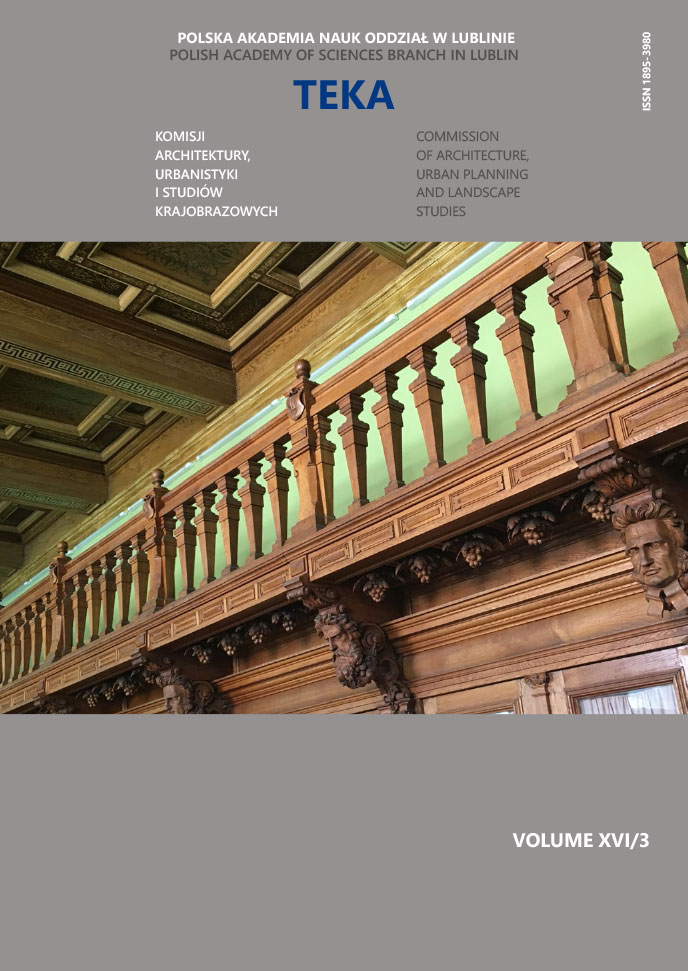Architecture of Polish water sports facilities located in parks in the interwar period
Article Sidebar
Open full text
Issue Vol. 16 No. 3 (2020)
-
Residential districts of the socialist realism period in Poland (1949−1956). Analysis, comparison and protection
Zuzanna Napieralska, Elżbieta Przesmycka7-18
-
Architecture of Polish water sports facilities located in parks in the interwar period
Wojciech Kocki19-23
-
The Truth in Architecture as a Synthesis of Material and Ideas – Brick Architecture of Białystok
Andrzej Tokajuk24-32
-
Adaptation and embedding of modern military objects on the example of the Kłodzko Fortress
Katarzyna Drobek33-41
-
Comparative method with the use of laser scanning as a starting point for the assessment of the state of preservation of the face of the walls in the Kłodzko Fortress
Piotr Gleń, Karol Krupa42-49
-
Architecture in the public space – streets and squares under the conditions of urban globalization
Dariusz Gaweł50-57
-
Surveing housing districts of Lublin: building types and energy performance
Anna Ostańska58-65
-
Architectural Methods of Protecting the Existing Trees in the City. Case Study
Wojciech Jabłoński66-73
-
Selected determinants of multi-family housing in Katowice in the 2030 perspective
Beata Komar74-83
-
Adaptation of form based code method in the Polish spatial planning system
Bartosz Kaźmierczak84-92
Archives
-
Vol. 18 No. 4
2022-12-30 5
-
Vol. 18 No. 3
2022-12-27 5
-
Vol. 18 No. 2
2022-12-27 5
-
Vol. 18 No. 1
2022-12-27 4
-
Vol. 17 No. 4
2021-12-30 11
-
Vol. 17 No. 3
2021-12-30 9
-
Vol. 17 No. 2
2021-12-30 8
-
Vol. 17 No. 1
2021-12-30 8
-
Vol. 16 No. 4
2020-12-30 11
-
Vol. 16 No. 3
2020-09-30 10
-
Vol. 16 No. 2
2020-06-30 11
-
Vol. 16 No. 1
2020-03-31 10
-
Vol. 15 No. 4
2019-12-30 6
-
Vol. 15 No. 3
2019-10-31 9
-
Vol. 15 No. 2
2019-06-28 12
-
Vol. 15 No. 1
2019-03-29 13
-
Vol. 14 No. 3
2018-10-28 14
-
Vol. 14 No. 2
2018-06-29 14
-
Vol. 14 No. 1
2018-03-30 13
Main Article Content
DOI
Authors
Abstract
In the interwar period, many sports and recreation facilities were built in Poland. Some of them were located in unique spaces with significant aesthetic and environmental values. One of the examples of such facilities are open swimming pools in the city of Wisła, Ciechocinek and Lviv. Examples of these objects show thoughtful compositional and urban solutions. Such a location of the facilities surrounded by nature was conducive to rest and practicing sports undisturbed by city noise. The location of water sports facilities in parks had many advantages which resulted in better conditions for practicing sports.
Keywords:
References
Kordiak J., Szklane domy, wizje i praktyki modernizacji społecznych po roku 1918, Zachęta – Narodowa Galeria Sztuki, Warszawa 2018. s. 77.
Mały Rocznik Statystyczny 1939, Główny Urząd Statystyczny Rzeczpospolitej Polskiej, Rok X, Warszawa 1939, s.20
Pawlikowska-Piechotka A., Piechotka M., Dzieje obiektów sportowych w Europie, Historia architektury sportowej od czasów starożytnych do współczesności, Akademia Wychowania Fizycznego Józefa Piłsudskiego w Warszawie, Podręcznik akademicki, Warszawa, 2017. s. 261.
Wereszyńska W., Statki na trawie i kropla wody – styl streamline w architekturze i wzornictwie przemysłowym w latach trzydziestych XX wieku w Stanach Zjednoczonych, Europie i Polsce, ARCHITECTURAE et ARTIBUS – 2/2015.
https://www.lwow.info, odczyt: 22−08−2019.
Article Details
Abstract views: 215
License

This work is licensed under a Creative Commons Attribution-ShareAlike 4.0 International License.


